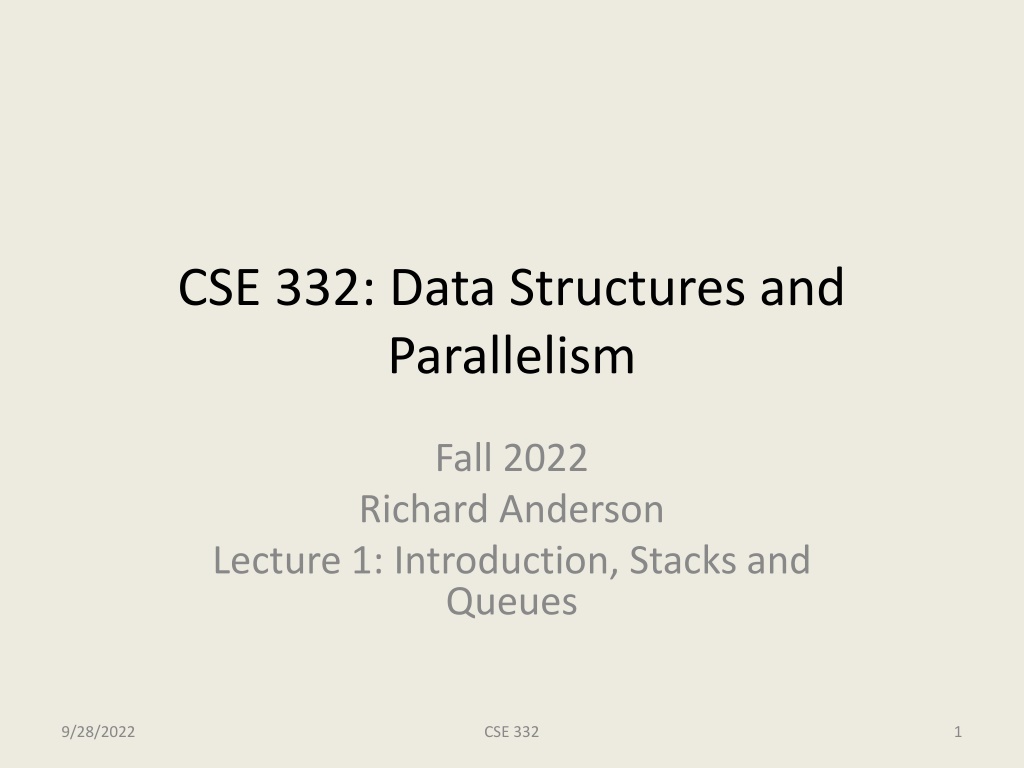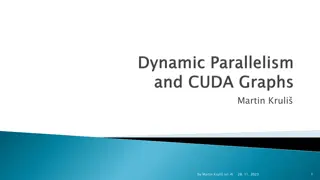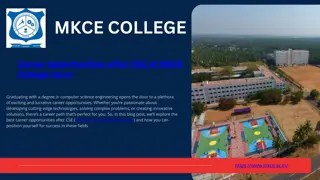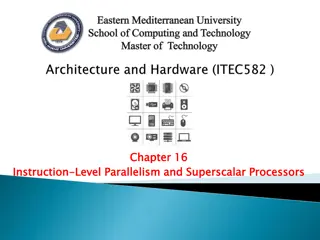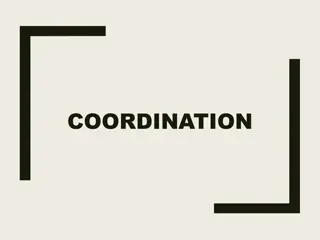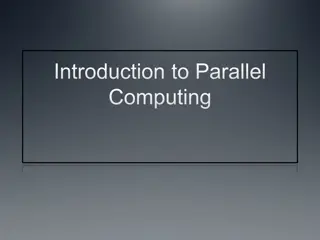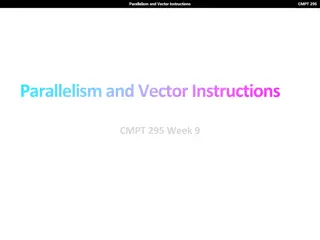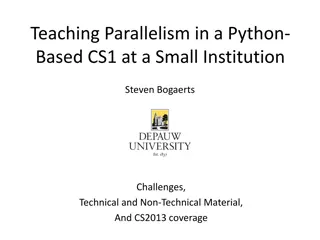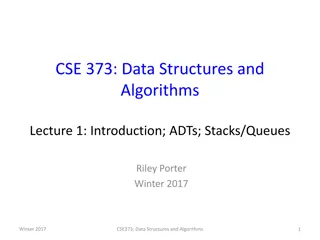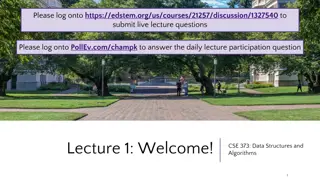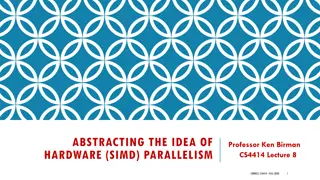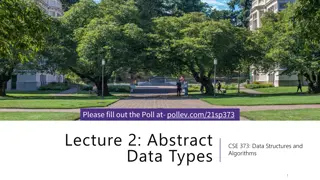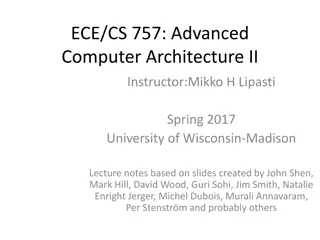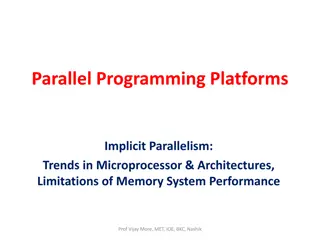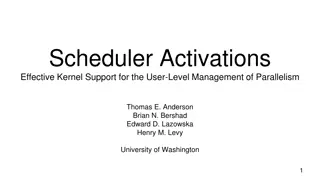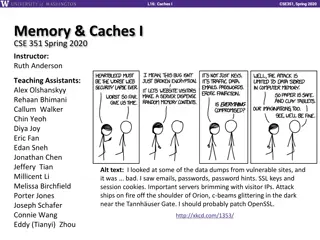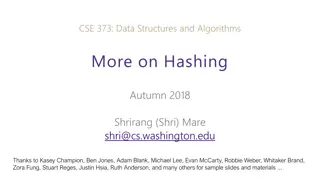Introduction to CSE 332: Data Structures and Parallelism with Richard Anderson
Welcome to CSE 332: Data Structures and Parallelism with Richard Anderson! This course covers fundamental data structures, algorithms, efficiency analysis, and when to use them. Topics include queues, dictionaries, graphs, sorting, parallelism, concurrency, and NP-Completeness. The outline includes introductions, administrative info, and a review of queues and stacks. Coursework involves homework exercises, programming projects in Java using Gitlab, and exams. Textbook by Mark Weiss is recommended. Don't miss office hours and section practice problems!
Download Presentation

Please find below an Image/Link to download the presentation.
The content on the website is provided AS IS for your information and personal use only. It may not be sold, licensed, or shared on other websites without obtaining consent from the author. Download presentation by click this link. If you encounter any issues during the download, it is possible that the publisher has removed the file from their server.
E N D
Presentation Transcript
CSE 332: Data Structures and Parallelism Fall 2022 Richard Anderson Lecture 1: Introduction, Stacks and Queues 9/28/2022 CSE 332 1
Welcome! Fundamental data structures and algorithms for organizing and processing information Classic data structures / algorithms and how to analyze rigorously their efficiency and when to use them Queues, dictionaries, graphs, sorting, etc. Parallelism and concurrency (!) NP-Completeness (!!) 9/28/2022 CSE 332 2
CSE 332 Team Instructor: Richard Anderson, CSE2 344 TAs: Nathan Akkaraphab Arya Krisna Winston Jodjana Sylvia Wang Amanda Yuan Allyson Mangus Rahul Misal Chandni Rajasekaran 9/28/2022 CSE 332 3
Todays Outline Introductions Administrative Info What is this course about? Review: queues and stacks 9/28/2022 CSE 332 4
Course Information http://www.cs.washington.edu/332 9/28/2022 CSE 332 5
Course Information Course Website Ed Message Board Gradescope Panopto Recordings 9/28/2022 CSE 332 6
Text Book Data Structures and Algorithm Analysis in Java, 3rd Edition. Mark Weiss UW Bookstore, $184.25 Amazon, $132.98 ($61.91 Used) eTextbook, $74.99 Paperback, $58.00 eBay, $4.73 (2nd Edition) 9/28/2022 CSE 332 7
Course meetings Lecture Materials posted (sometimes afterwards), but take notes Ask questions, focus on key ideas (rarely coding details) Section Practice problems! Answer Java/project/homework questions, etc. Occasionally may introduce new material An important part of the course (not optional) Office hours Use them: please visit us! 9/28/2022 CSE 332 8
Course Work ~20 Weekly individual homework exercises 3 programming projects (with phases) Use Java, Gitlab Single person projects (this is a change from previous quarters) Midterm and final exam In class Midterm: Friday, November 4 Final: Thursday, December 15, 8:30 AM. 9/28/2022 CSE 332 9
Overall grading Grading 25% - Written Homework Assignments 35% - Programming Assignments 15% - Midterm Exam (Nov 4) 25% - Final Exam (Dec 15, 8:30 AM) 9/28/2022 CSE 332 10
Section Meet on Thursdays What happens there? Answer questions about current homework Previous homeworks returned and discussed Discuss the project (getting started, getting through it, answering questions) Finer points of Java, etc. Reinforce lecture material 9/28/2022 CSE 332 11
Homework for Today!! 1. Project #1: Checkpoint 1, Oct 6 at 11:59 pm 2. Exercise #1: Due Monday, Oct 3 at 11:59 pm 3. Review Java 4. Reading in Weiss (see course web page) (Topic for Project #1) Weiss 3.1-3.7 Lists, Stacks, & Queues (Friday) Weiss 2.1-2.4 Algorithm Analysis (Useful) Weiss 1.1-1.6 Mathematics and Java 9/28/2022 CSE 332 12
Todays Outline Introductions Administrative Info What is this course about? Review: Queues and stacks 9/28/2022 CSE 332 13
Common tasks Many possible solutions Choice of algorithm, data structures matters What properties do we want? 9/28/2022 CSE 332 14
Why should we care? Computers are getting faster No need to optimize Libraries: experts have done it for you 9/28/2022 CSE 332 15
Program Abstraction Problem defn: Algorithm: Implementation: 9/28/2022 CSE 332 16
Data Abstraction Abstract Data Type (ADT): Data Structure: Implementation: 9/28/2022 CSE 332 17
Trade offs: storing a set 9/28/2022 CSE 332 18
Terminology Abstract Data Type (ADT) Mathematical description of an object with set of operations on the object. Useful building block. Algorithm A high level, language-independent, description of a step- by-step process. Data structure A specific organization of the data to accompany algorithms for an abstract data type. Implementation of data structure A specific implementation in a specific language. 9/28/2022 CSE 332 19
Todays Outline Introductions Administrative Info What is this course about? Review: queues and stacks 9/28/2022 CSE 332 20
First Example: Queue ADT FIFO: First In First Out Queue operations create destroy enqueue dequeue is_empty dequeue enqueue G F E D C B A 9/28/2022 CSE 332 21
Queues in practice Print jobs File serving Phone calls and operators (Later, we will consider priority queues. ) 9/28/2022 CSE 332 22
Array Queue Data Structure size - 1 0 Q b c d e f back enqueue(Object x) { Q[back] = x back = (back + 1) } What s missing in these functions? How to find K-th element in the queue? dequeue() { x = Q[0] shiftLeftOne() back = (back 1) return x } 9/28/2022 CSE 332 23
Circular Array Queue Data Structure size - 1 0 Q b c d e f enqueue(Object x) { assert(!is_full()) Q[back] = x back = (back + 1) } front back How test for empty/full list? How to find K-th element in the queue? dequeue() { assert(!is_empty()) x = Q[front] front = (front + 1) return x } 9/28/2022 What to do when full? CSE 332 24
Linked List Queue Data Structure b c d e f front back void enqueue(Object x) { if (is_empty()) front = back = new Node(x) else { back->next = new Node(x) back = back->next } } bool is_empty() { return front == null } 9/28/2022 Object dequeue() { assert(!is_empty()) return_data = front->data temp = front front = front->next delete temp return return_data } CSE 332 25
Circular Array vs. Linked List Advantages of circular array? Advantages of linked list? 9/28/2022 CSE 332 26
Second Example: Stack ADT LIFO: Last In First Out Stack operations create destroy push pop top is_empty E D C B A A B C D E F F 9/28/2022 CSE 332 27
Stacks in Practice Function call stack Removing recursion Balancing symbols (parentheses) Evaluating postfix or reverse Polish notation 9/28/2022 CSE 332 28
Assigned readings Reading in Weiss Chapter 1 (Review) Mathematics and Java Chapter 2 (Next lecture) Algorithm Analysis Chapter 3 (Project #1) Lists, Stacks, & Queues 9/28/2022 CSE 332 29
